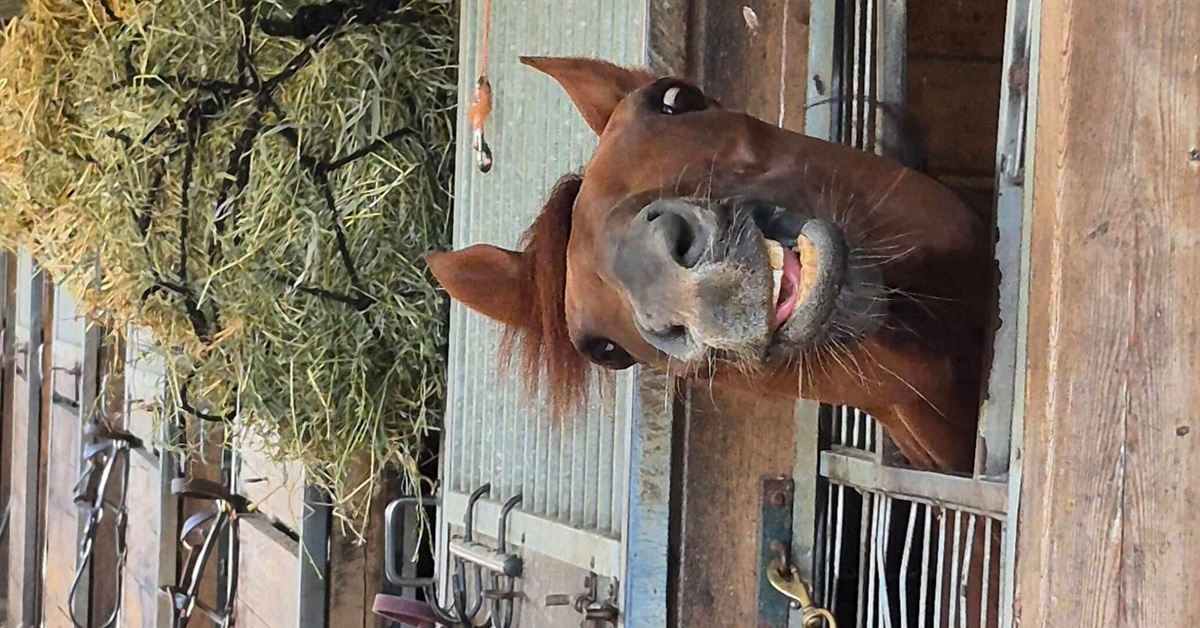In late March, an outbreak of strangles closed the Saratoga Casino and Raceway in upstate New York for three weeks. As spring competition season approaches, it is important to remember that strangles is a highly infectious disease that can have severe consequences for horses. Understanding what it is, how it is spread and treatment options can prove to be a lifesaver for your horse.
What is it?
Strangles, explains Penn Vet Assistant Professor of Medicine Ashley G. Boyle, DVM, DACVIM, is an infection caused by the bacteria Streptococcus. equi subsp equi. It can cause severe swelling of the lymph nodes around the throat, making it difficult for a horse to breathe; hence the name, strangles.
Dr. Boyle, who works at Penn Vet’s New Bolton Center in the Section of Field Service, says that strangles should be strongly suspected if a horse suddenly develops a high fever — sometimes higher than 103°F — and appears lethargic or depressed. After the onset of a fever, there will be discharge from the nose, and the lymph nodes in the neck and under the jaw can enlarge. If abscesses develop in the lymph nodes, the airway will be narrowed making breathing noisy and swallowing difficult. The horse may hold its neck out straight looking for relief. In horses under the age of five (who have yet to develop normal immunity), horses older than 20, or immune-compromised horses, the signs of strangles will be more pronounced.
In some cases —as many as 20% says Dr. Boyle —S. equi spreads through the blood or lymphatic system, resulting in abscesses that can affect any organ system. “Bastard strangles,” as this condition is known, may appear like colic, even many months after the initial strangles exposure.
In other cases, a mild to life-threatening autoimmune reaction to the bacteria known as purpura hemorrhagica can occur in mature horses after repeated natural exposure to infection.
How did this happen?
Strangles is spread when one horse passes the bacteria to another through close proximity or contact. Equipment such as water buckets, feed buckets, tack and twitches — even clothing and equipment — can also be vehicles for passing bacteria, which, particularly in moist environments, can persist for extended periods. “The bacterium,” explains Dr. Boyle, “attaches to the tonsils, and signs of the illness develop three to 14 days after exposure.”
A horse that has strangles will begin to shed the bacteria after the fever, and for up to six weeks. Outwardly healthy horses, showing no sign of infection, can also be carriers silently shedding bacteria. It’s one of the dangers with this disease. On a more positive note, 75% of horses that have been infected with S. equi subsp equi and have not been vaccinated for strangles will be immune to the illness for up to five years. (Can you add a line here about why or illustrate it with something similar?)
Is it strangles?
Early diagnosis is essential for containing this highly infectious disease. Results of bacterial culture of abscess fluid and nasopharyngeal swabs/washes can be read in 24 hours. Even faster is a PCR (polymerase chain reaction), which can detect the DNA of the offending organism with same-day results.
If a horse is suspected of carrying the bacterium, an endoscopic examination of the guttural pouches (air-filled pockets on either side of the back of the throat) as well as culture and PCR testing of guttural pouch fluid can determine if the bacteria are present.
Examination of serum from a blood test is useful for detecting recent, but not current, infection; assessing the need for vaccination; identifying horses that may be predisposed to purpura hemorrhagica; and diagnosing S. equi subsp equi–associated purpura hemorrhagica and bastard strangles.
Treatment
The goal of treating strangles is three-fold: to control transmission, eliminate infection and provide future immunity to the disease. Uncomplicated cases of strangles are often left to run their course with supportive care, providing lasting immunity. Affected horses should be isolated in a clean, dry stall and fed moist, palatable food. Non-steroidal anti-inflammatories may be used to decrease swelling and promote eating. Hot compresses or topical 20% ichthammol can be used on abscesses. Your vet may choose to lance abscesses to allow drainage, followed by daily flushing with a dilute iodine solution.
“The use of antimicrobials for treating strangles is controversial,” says Dr. Boyle. “During the acute phase of fever and depression they may prevent abscess formation, but they will also prevent the development of lasting immunity.” In certain cases, however, it is necessary. “Horses with complications such as lack of response to supportive therapies, metastatic disease or purpura require the use of systemic antimicrobials for extended periods. Penicillin is the preferred antimicrobial.” Horses with severely enlarged lymph nodes and difficulty breathing, she adds, often require emergency surgery to cut a hole in the trachea to free the horse’s airway; cases of purpura hemorrhagica also require the use of systemic corticosteroids.
With strangles, pus tends to accumulate in the guttural pouch, and will need to be removed with special equipment, followed with local application of penicillin gel. If not, pus will dry in to rock-hard pebbles that may require surgery to remove.
Vaccination
Dr. Boyle says an intranasal vaccine is recommended to protect horses against strangles. Two initial boosters are given three weeks apart, followed by annual boosters. The intranasal vaccine should not be given concurrently with other routine intramuscular vaccines or invasive procedures in order to avoid contamination of the intramuscular injection or surgical site. Use of vaccination during an outbreak is not recommended due to the risk of purpura.
Protect your horses against an outbreak
Most outbreaks are thought to originate from introduction of an infected horse into an unprotected population. The following recommendations will help avoid an outbreak, or reduce the risk from an outbreak should one occur:
• New horses should be isolated for three weeks and monitored for signs of disease, including fever.
• Once an outbreak has occurred, take the temperatures of all horses on the farm twice daily. Identifying horses with elevated temperatures enables handlers to isolate these horses before shedding occurs.
• Quarantine the facility to stop all movement on and of the farm.
• Caretakers should change clothing between visits to infected and non-infected horses, and designated equipment should be used.
• Water buckets should be disinfected daily.
• Remove all material from stalls where infected horses have been housed and clean with detergent, then disinfect with a phenol, an iodophor, or a chlorhexidine compound. Surfaces and equipment must be allowed to dry thoroughly.
• Rest infected paddocks for three weeks.
• Carriers are the reason this disease still exists, and the percentage of carriers per outbreak could be as high as 10%. When all cases of strangles have been resolved, throat washes from recovering horses by PCR and culture to detect carriers. Further testing of the guttural pouch should be performed via endoscopy for any horses found to be positive.
More News









